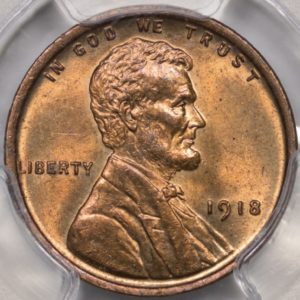Lincoln Cents, Wheat Reverse (1909-1958)
There was a tradition of not putting a portrait of an actual figure in US currency. That practice lasted for years until 1909, with the release of the Lincoln Cent on the centennial of Abraham Lincoln’s birth.
The idea of using a public figure on a US coin is nothing new. Mint Director James Ross Snowden floated the idea of putting Columbus on the cent, but eventually settled with the Indian Head design.
In 1909, Theodore Roosevelt was president of the United States. He was determined to make changes to American coinage, and was able to successfully get four gold denominations redesigned. This time, he looked toward the one cent, which featured an Indian head since 1859.
History of the Lincoln Cent, Wheat Reverse Coin
George Washington disliked the idea of putting actual people on US money. He found the idea too monarchical, and since then the government issued coins featuring figures like the female personification of Liberty.
Tradition was finally broken when Theodore Roosevelt was president. He was very involved in many affairs, including American coinage. He already had four gold coins redesigned and set his eyes next on the one cent.
Given 1909 was the centennial of Lincoln’s birth, what better way to honor the man than by putting his image on the one-cent coin. Victor David Brenner, a Lithuanian immigrant and sculptor, was asked to do the honors. Roosevelt had sat for him before and was impressed with a plaque he made of Lincoln in 1907.
Design of the Lincoln Cent, Wheat Reverse Coin
The Lincoln penny continues to be the current design to this day, but it has gone through changes since it was first released in 1909. The Lincoln Cent, Wheat Reverse design was the first and it was produced until 1958.
Brenner designed the obverse to feature Lincoln’s portrait facing the right. Above the bust are the words IN GOD WE TRUST, the first time they appear on a one cent coin. Inscribed on the left of the portrait is the word LIBERTY while the date is on the right.
The reverse of the Lincoln one-cent coin features two sheaves of wheat on either side of the coin’s value. Below the coins value in smaller type are the words UNITED STATES OF AMERICA while the motto E PLURIBUS UNUM circles above.
Collecting the Lincoln Cent, Wheat Reverse Coin
The Lincoln Cents, Wheat Reverse design was met with controversy, but complaints soon died down. Instead, many complained about the presence of the artist’s initials, V.D.B. That issue was rectified but the 1909 Lincoln cent soon became a coveted coin in the series.
Brenner’s initials again made an appearance starting in 1918, but this time in much smaller type. The Lincoln Cent, Wheat Reverse coin was produced in large quantities over the years, with the Philadelphia Mint being the largest producer. The Philadelphia Mint also produced matte-proof Lincoln cents from 1909 to 1916. Brilliant proofs were made from 1936 to 1942 and picked back up from 1950 to 1954. The San Francisco and Denver mints also produced the coin.
Only the 1909 Lincoln Cent with V.D.B. initials and the 1931 Depression Era Lincoln cent had mintages below one million. The 1941 Denver Lincoln Cent is one of the most coveted in the series. The San Francisco mint mostly struck the fewest number of coins, with versions released in 1910, 1911, 1912, 1913, 1914, and 1915 being scarce. The 1924 Lincoln cent struck in Denver is also scarce.
The Lincoln Cent has been made using copper, but with the metal being needed for combat purposes, the 1943 edition used zinc-coated steel. Since that proved unsatisfactory, brass alloy was used from 1944 to 1946. The US Mint also struck small numbers of the 1943 cents in bronze, as well as large quantities of 1944 cents in steel – both are rare and valuable.
Lincoln continues to be the figure featured in one-cent pieces to this day.
Check PCGS Price Guide
Check NGC Price Guide
Back to Home Page
